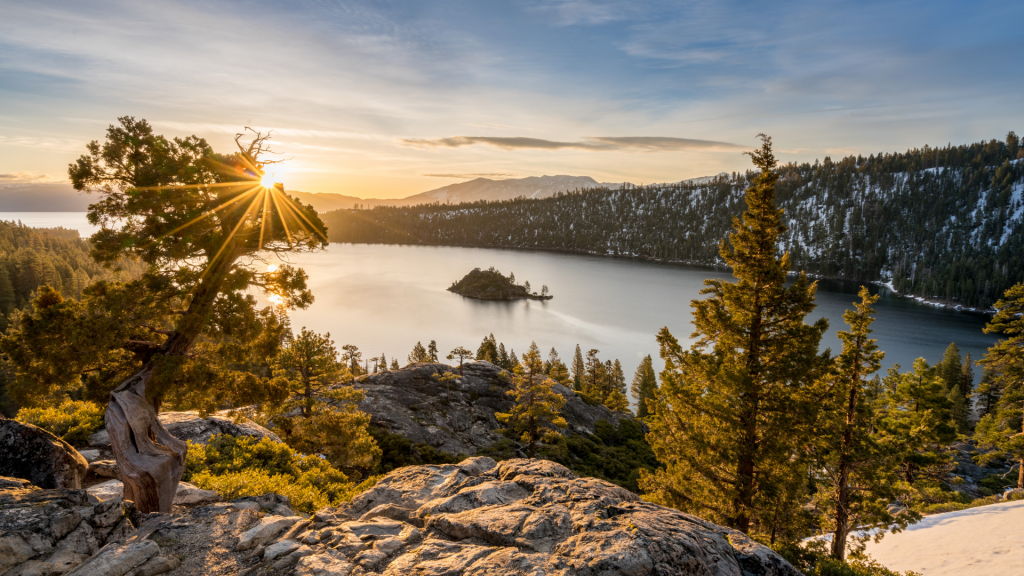Weather in Lake Tahoe: A Guide to Plan Your Visit
Lake Tahoe offers some of the most beautiful scenery you will ever see. But, before you pack your bags, you need to know everything about its weather. This guide covers everything you need to know about Lake Tahoe’s weather, from its location to its unique features, and what to plan for your visit.

Location and Climate
Lake Tahoe is located in the Sierra Nevada Mountains and straddles the California-Nevada state line. Generally speaking, Lake Tahoe’s weather is sunny and pleasant, with cool breezes during summers and cold winters with abundant snowfall. Due to its high altitude of 6,225 feet (1.9 km), the region is characterized by frequent and sudden weather changes.
Seasons in Lake Tahoe
Spring (March to May)
This season is known for its mild temperatures and occasional snowfall, particularly in early spring. The average high temperature ranges from 50 °F (10 °C) to 70 °F (21.11 °C).
Summer (June to August)
Summers are warm and sunny with average high temperatures ranging from 75 °F (23.89 °C) to 80 °F (26.67 °C). This season provides excellent opportunities for water sports and hiking.
Autumn (September to November)
Fall in Lake Tahoe is characterized by vibrant fall foliage and cooler temperatures, with highs ranging from 70 °F (21.11 °C) in September to 50 °F (10 °C) in November.
Winter (December to February)
Winters are cold with abundant snowfall, making it a paradise for winter sports enthusiasts. Average high temperatures hover around 42 °F (5.56 °C) in December and 39 °F (3.89 °C) in February.
Remember, the weather can change quickly due to Lake Tahoe’s high altitude, so always check the forecast before heading out for the day.

Unique Weather Features
Lake Tahoe experiences several distinctive weather features, such as the ‘Sierra Wave’ and ‘Lake Effect Snow.’ The Sierra Wave is a type of mountain wave, where strong winds blow across the mountain and produce standing and lenticular clouds. Lake Effect Snow occurs during winter when a storm travels over Lake Tahoe, which causes warm, moist air to rise above the cold, dry air of the region and produces heavy snow. These weather phenomena are truly a sight to behold and help create a unique experience for visitors.
Wildlife and Activities
Lake Tahoe is known for its wildlife and activities. Visitors can spot a variety of animals, including bald eagles, black bears, and coyotes. In summer, you can enjoy fishing, zip-lining, or taking a hot air balloon ride. During winters, the highlight of the region is skiing and snowboarding. But if you don’t like snow sports, worry not. You can go ice skating, snowshoeing, or even take a sleigh ride through the snowy woods.
Common queries about the weather in Lake Tahoe
Which is the best season to visit the lake?
The best season to visit Lake Tahoe is subjective and entirely depends on personal preference. Summer offers warm days and clear skies, making it perfect for water activities such as kayaking, paddleboarding, and swimming. Autumn is an ideal time for hiking and sightseeing, with beautiful fall foliage and fewer crowds. Winter brings plenty of snow, making it perfect for skiing, snowboarding, and other winter sports. Spring is also an excellent time to visit Lake Tahoe, with mild temperatures and the blooming of wildflowers.
What is the hottest month at Lake Tahoe?
The hottest month at Lake Tahoe is typically July, when temperatures often peak in the low 80s Fahrenheit (around 27–28 degrees Celsius). However, due to the region’s high altitude, evenings can still be quite cool, so it’s advisable to pack layers when planning a visit. July’s warm and sunny weather makes it a fantastic time for water activities on the lake, such as swimming, boating, and paddleboarding. However, always remember to check the weather forecast before planning your activities for the day.
Is it safe to drive near Lake Tahoe during winter?
Driving near Lake Tahoe during winter requires careful preparation and caution due to the snowy and icy conditions. Although the roads are regularly plowed and maintained, winter storms can quickly lead to treacherous driving conditions. It’s essential to carry tire chains and know how to use them, even if your vehicle has four-wheel drive or snow tires. Always check the weather forecast and road conditions before heading out, and avoid traveling during severe weather if possible.

Conclusion
Lake Tahoe is a mesmerizing place; it offers so much in terms of natural beauty and outdoor activities. If you are planning a trip, consider the season and plan accordingly. The weather changes quickly, so always pack extra layers, especially if you are visiting during winter or spring. Each season brings a unique charm to the region, so don’t let the cold weather stop you from experiencing all that Lake Tahoe has to offer. Whether you are a seasoned traveler or just starting to explore, Lake Tahoe is a place that you don’t want to miss!







